Suspension bridges vibrate during earthquakes and strong winds. This 1:500 scale model of the Golden Gate Bridge displays vibration patterns (also known as vibration modes) inherent in suspension bridges. Chain is used to model the cables and segmented pieces are used to model the roadway deck, so the vibration patterns are exaggerated and more easily seen.
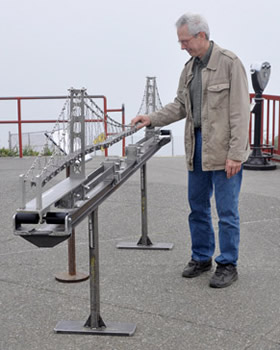
Watch an exciting video of the Exploratorium's dynamic model of the Golden Gate Bridge. What happens to the Bridge during an earthquake? How about strong winds and heavy traffic? The model dances and wiggles realistically, displaying the same vibrational modes and motions that occur in the actual Bridge!
Types of Motion - See how the Bridge moves
Swaying in the wind
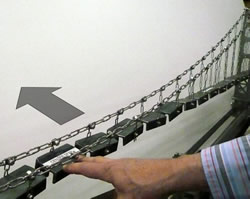 |
On the model, push the CENTER SPAN area to one side and release.
This is the fundamental transverse vibration mode. The Golden Gate Bridge takes about 20 seconds to complete one back-and-forth swing. The amount of time to complete one back-and-forth cycle is the period of vibration. Very large and heavy structures like the Golden Gate Bridge move slowly and therefore have long periods of vibration. The model is smaller and lighter than the actual Bridge, so it vibrates faster. When steady westerly winds blow across the Bridge deck, they push the deck to the east, usually bending or bowing a few feet, or about a meter. For very strong winds, the deck is designed to bow horizontally at the middle of the center span 27.7 feet (8.4 meters). |
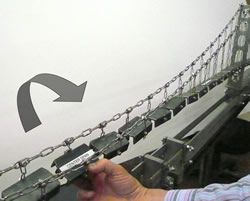 |
Twist and pull down on the CENTER SPAN area.
Notice how the deck on either side twists in the opposite direction. Twist and pull down on the deck section labeled 1/4 SPAN. Notice how the deck on the opposite side twists in the other direction. This pattern of twisting, or torsional vibration mode, led to the collapse of the Tacoma Narrows Bridge in 1940.
|
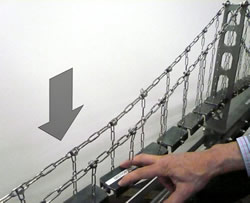 |
Press down on the CENTER SPAN and quickly release it.
Notice the deck oscillates or vibrates up and down about 2 times per second. This is the fundamental vertical vibration mode of this model. The Golden Gate Bridge, 500 times larger, takes about 8 seconds to complete one cycle of this oscillation. |
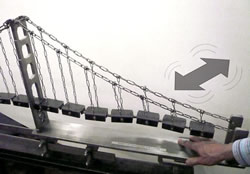 |
Shake the ANCHORAGE area back and forth.
Notice how waves travel along the deck. Try shaking faster and slower. Which rate makes the bridge model move more? Bridges respond or resonate more intensely to earthquakes when the ground shaking motion matches the period of vibration of the bridge. |
Explore this Topic Further
Golden Gate Bridge Vibration
Video of Bridge Vibration Modes by Dave Fleming of the San Francisco Exploratorium (all ages)
Dave Fleming demonstrates the vibration model of the Bridge that is part of the outdoor exhibit in the visitor area at the San Francisco end of the Bridge. From 0:55 to 1:29 minutes he demonstrates two torsional modes of vibration. (2:12 minute video)
Animation of the Golden Gate Bridge in an Earthquake created by Computers & Structures, Inc. (all ages)
This animation exaggerates the motions of the types of vertical, horizontal and twisting vibrations that the Golden Gate Bridge would experience in a repeat of the 1906 earthquake. (20 second video)
Tacoma Narrow Bridge Vibration and Collapse
Tacoma Narrows Bridge Collapse (all ages)
This 1940 news clip documents the large vibrations and then collapse of the Tacoma Narrows Bridge in 42 mile-per-hour winds. (2:35 minute video)
Lessons Learned from the Collapse of the Tacoma Narrows Bridge from Washington State Department of Transportation (grade 6 to adult)
The collapse of the Tacoma Narrows Bridge reinforced for designers the importance of deck weight and stiffness in the stability of a suspension bridge deck. The “torsional flutter” of the bridge due to wind excitation was not anticipated.
Waves and Vibration
Properties of Periodic Motion from the Physics Classroom (grades 6 to adult)
This lesson introduces important vibration concepts such as periodic motion, cycle of vibration, frequency, period, amplitude, damping, and energy dissipation.